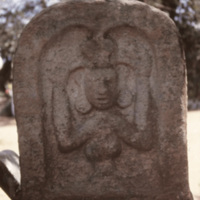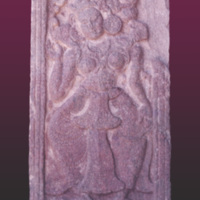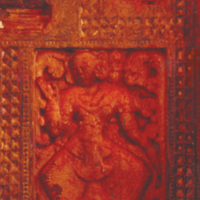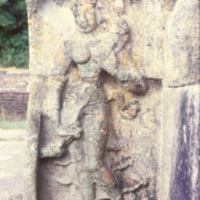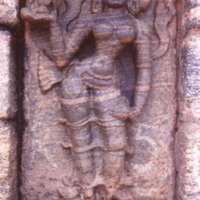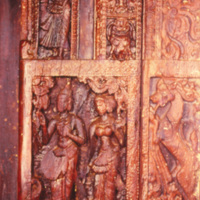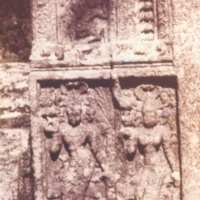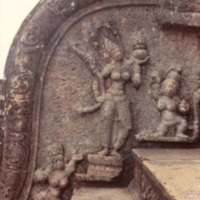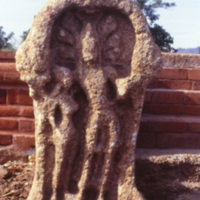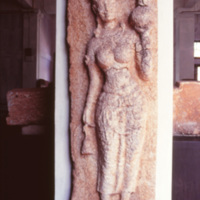Main Menu
AORC Libraries
Browse Archive Items (166 total)
Earth goddesses
Description: These two female busts are identified as the earth goddesses or polovamahikanthava who acts as guardians. They seem to rise out of the earth from their placement at the entrance to a Buddhist temple. This guardstone, is one of two found at the entrance to the precincts of the Dippitiya Vihare in the Kegalle district, Sri Lanka. The temple is dated in the Kandyan period (16th-18th century A.D.).
Contributor: Co-Author: Seneviratna, Harsha
Collection: Women in Sri Lankan Sculpture and Painting
Tags: AISLS, Attendant Goddesses, ICES, PDWESLSP
Women as door guardians
Description: This dvarapalika (female door guardian), carved at the entrance of a Buddhist religious building was considered to be auspicious. Attributed to the Kandyan period (16th-18th century A.D.), this stone relief was found during excavations in the Kandy Cultural Project area and can be seen at the Cultural Triangle Project Office in Kandy, Sri Lanka.
Contributor: Co-Author: Seneviratna, Harsha
Collection: Women in Sri Lankan Sculpture and Painting
Female dancers as guardians of temples
Description: Female door guardians or dvarapalikas in dance poses emphasize the devotional stance of these goddesses. This carved relief is at the bottom of one of the wooden door jambs at the entrance to the shrine of the main Buddhist temple at Vakirigala in the Kegalle district, Sri Lanka. Stylistically this sculpture belongs to the Kandyan period (16th-18th century A.D.).
Contributor: Co-Author: Seneviratna, Harsha
Collection: Women in Sri Lankan Sculpture and Painting
Tags: AISLS, Attendant Goddesses, ICES, PDWESLSP
Carved Apsaras
Description: On the jambs of the entrance doorway at the top of the stairway at Yapahuva, Sri Lanka are carved panels of apsaras or divine maidens, carrying musical instruments, expressing devotion or bhakti. The buildings at Yapahuva, Sri Lanka, are attributed to the 13th century A.D. by historians.
Contributor: Co-Author: Seneviratna, Harsha
Collection: Women in Sri Lankan Sculpture and Painting
Tags: AISLS, Attendant Goddesses, ICES, PDWESLSP
Female guardians
Description: On either side of the steps leading to the main building among the ruins at Yapahuva, Sri Lanka, are carved panels, with single female guardians. Although not naginis (female cobras), their shawls twirl up like cobra hoods. They carry pots of plenty symbolizing prosperity and good luck. The buildings at Yapahuva, Sri Lanka are attributed to the 13th century A.D. by art historians.
Contributor: Co-Author: Seneviratna, Harsha
Collection: Women in Sri Lankan Sculpture and Painting
Tags: AISLS, Attendant Goddesses, ICES, PDWESLSP
Guardian Deities
Description: The idea of the joint role of male and female as guardian deities is conveyed in this wood-carving at the Uda Aludeniya temple near Gampola, Sri Lanka. The couple at the bottom of the door jambs here are not represented as nagas (cobras), but there seems to be a close parallel with a stone sculpture seen at Kurunegala, Sri Lanka. Two females bearing chamaras or fly whisks are carved on two upper panels of the door jambs. They are perhaps attendant goddesses. A date in the 14th century A.D. has…
Contributor: Co-Author: Seneviratna, Harsha
Collection: Women in Sri Lankan Sculpture and Painting
Tags: AISLS, Attendant Goddesses, ICES, PDWESLSP
Pairs of Cobra-guardians.
Description: Two pairs of naga-nagini couples (male and female cobras in human form) are the joint guardians at the bottom of the door jambs at the entrance to a ruined building in the premises of the Government Agent’s Residency at Kurunegala, Sri Lanka. The naga and nagini are of almost equal height indicating an improved status for the female in this stone sculpture, probably dating from the 14th century.
Contributor: Co-Author: Seneviratna, Harsha
Collection: Women in Sri Lankan Sculpture and Painting
Cobra-guardians
Description: Carved on the balustrades on either side of the Lankatilaka Vihare at Polonnaruva, Sri Lanka, are two naga and nagini (male and female cobras in human form) guardians from the 12th century A.D. The nagini is on the inner side of the left balustrade as you enter. Her head is framed by the same number of hoods as the naga on the opposite side indicating the naga and nagini were both considered equally important functionally in their role as guardian. With the nagini are attendant female dwarfs,…
Contributor: Co-Author: Seneviratna, Harsha
Collection: Women in Sri Lankan Sculpture and Painting
Cobra couple on a guardstone.
Description: This guardstone at the Dematamal Vihare in Okkampitiya in the Moneragala district, Sri Lanka, shows a cobra couple with arms round each other. It reflects the growing importance of the female in naga-nagini guardstones in the middle Anuradhapura period (ca. 5th-7th century A.D.).
Contributor: Co-Author: Seneviratna, Harsha
Collection: Women in Sri Lankan Sculpture and Painting
Nagini guardstone
Description: This stone relief sculpture of a woman carrying a pot and what looks like a bell is kept at the Colombo National Museum. A faint indication of a cobra hood over her head possibly represents a nagini (female cobra) guardian of the middle Anuradhapura period (ca. 5th-7th century A.D.). The original find spot of this sculpture is said to be Pidurangala, close to Sigiriya, Sri Lanka. A replica can be seen at the Archaeological Museum in Anuradhapura, Sri Lanka.
Contributor: Co-Author: Seneviratna, Harsha
Collection: Women in Sri Lankan Sculpture and Painting



